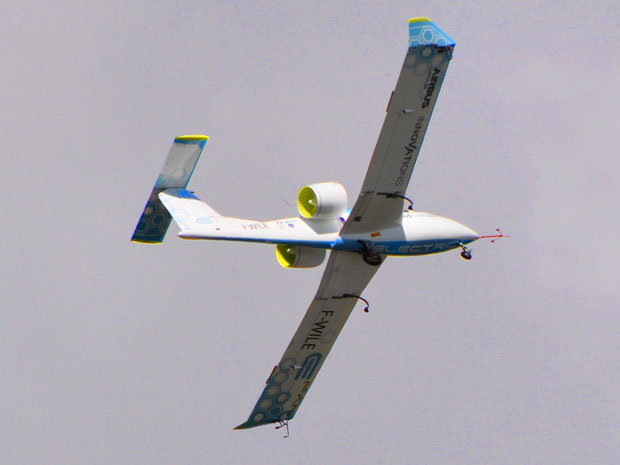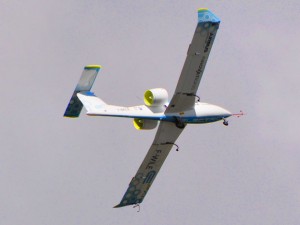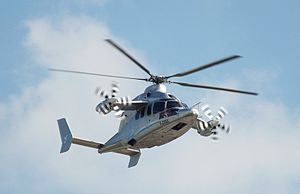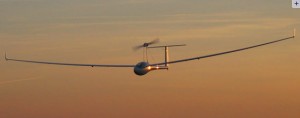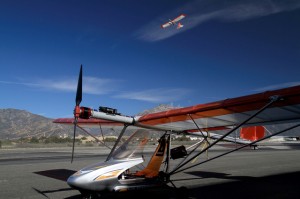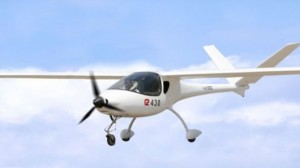July 14, 2014 – A new type of airplane is emerging in the 21st century – the E-Airplane and its cousin the e-Hybrid airplane. The technology is being driven by a number of small designers and one very large one, Airbus. Why? Because of green initiatives and better battery and electric power technologies. Among the latest E-Airplanes to soon appear at your local airport are the following.
E-Fan 2.0
Airbus demonstrated its E-Fan 2.0 all-electric two-seater aircraft back in April of this year. Currently a test airplane it comes equipped with two 125-volt batteries developed by Kokam, a Korean manufacturer of lithium-polymer storage technology. Each battery is housed in a wing and provides 60 Kilowatts of power to the two variable-pitch fan electric motors. Current range is 45 minutes in the air. A backup battery can be deployed for emergency landing. Commercial production is expected by 2017. A four-seater hybrid aircraft, the E-Fan 4.0, is under development. The combination of an internal combustion engine and battery pack will provide much greater flight range.
Airbus has also been testing hybrid designs for helicopters. The Eurocopter X3 is an extension of an older airframe using conventional power sources. The addition is a lithium-ion stack of batteries to help power the 5-blade rotary-wing, 2-seater helicopter. With battery power an X3 can run quietly during ascent and descent in urban areas reducing the common complaint of high levels of noise associated with traditional helicopter technology.
Lange Antares 20E
A cross between a powered airplane and glider, the Lange Antares 20E is a German designed single-seat electric aircraft. Lange has been flying electric airplanes successfully since 2011. With a range of about 190 kilometers (97 nautical miles) under power provided by Lithium-ion batteries, the aircraft’s enormous wingspan (18 meters) gives it the ability to glide extending its range. Current configuration allows for about 13 minutes of powered flight at maximum climbing speed. The operational powered flight time can be extended during horizontal flight. A more recent upgrade the 23E has a glide range of 60 kilometers (32 nautical miles) from a height of 1,000 meters (3,280 feet).
GreenWing eSpyder and e430
Located in California, GreenWing is a subsidiary of Yuneec International, a company with roots in China and Taiwan. GreenWing sells what Yuneec develops, and the company has two electric-powered aircraft currently available for early adopters of this technology.
The eSpyder is for the flight hobbyist. It is a kit that sells for under $40,000 U.S. A single-seat aircraft, it has a 10.13 meter (33 foot) wingspan and is powered by lithium batteries with 13 Kilowatt hours load capacity. The Yuneec developed electric motor generates 24 Kilowatts of power with a flight duration of between one and 1.5 hours. Recharge time takes between 2 and 3 hours.
On the other hand, the e430 is a serious electric aircraft with a two-hour flying range. It seats two and features a fast recharge and battery swap out for quick turnarounds upon landing. Empty it weighs 302 kilograms (666 pounds) and features a wingspan of 13.8 meters (45 feet). Maximum speed is 161 kilometers (87 nautical miles) per hour. The combination of electric motor and lithium battery produces 48 Kilowatts of power for its single prop. Conventional recharge time is 3 to 5 hours.
The aircraft mentioned here don’t represent all the inventors and manufacturers currently developing electric airplanes. But they indicate a trend to develop a non-fossil fuel alternative to the current aeronautical technology. Most of the companies invested in electric airplanes are small. But Airbus isn’t. So why are they so hot on electric airplane technology? The European Commission has established a guideline for its aeronautical future. It’s called Flightpath 2050 and has set ambitious target reductions in a number of critical areas. Based on year 2000 data avionics companies in or supplying Europe must produce technologies that lead to a net reduction in CO2 emissions by 75%, nitrous oxide by 90% and noise pollution by 65%. Electric and hybrid aircraft represent two ways to achieve these ambitious goals.
